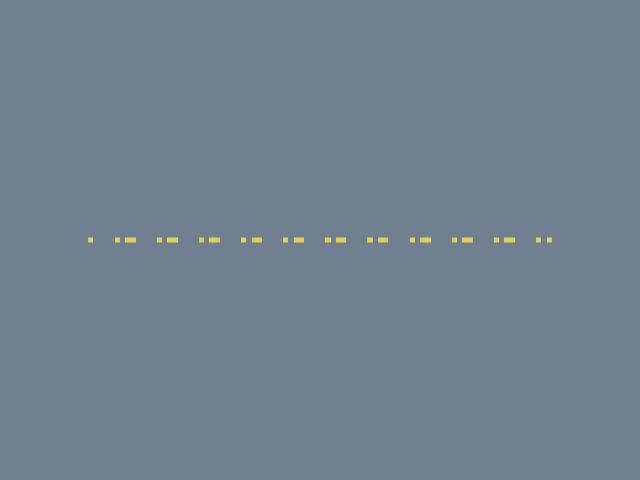StippledLine
Repository source: StippledLine
Description¶
VTK OpenGL2 no longer supports Stippled Lines. This example uses texture mapping to created stippled lines. Two parameters, StipplePattern and StippleRepeat, control the pattern of the stippled lines.
StipplePattern is a 16-bit binary pattern, 1 = pixel on, 0 = pixel off.
StippleRepeat is the stippling repeat factor of a Line, which specifies how many times each bit in the pattern is to be repeated.
It can be tricky to set the proper pattern and repeat, so experiment.
Other languages
See (Cxx)
Question
If you have a question about this example, please use the VTK Discourse Forum
Code¶
StippledLine.py
#!/usr/bin/env python
# noinspection PyUnresolvedReferences
import vtkmodules.vtkInteractionStyle
# noinspection PyUnresolvedReferences
import vtkmodules.vtkRenderingOpenGL2
from vtkmodules.vtkCommonColor import vtkNamedColors
from vtkmodules.vtkCommonCore import (
VTK_UNSIGNED_CHAR,
vtkDoubleArray
)
from vtkmodules.vtkCommonDataModel import vtkImageData
from vtkmodules.vtkFiltersSources import vtkLineSource
from vtkmodules.vtkRenderingCore import (
vtkActor,
vtkPolyDataMapper,
vtkRenderWindow,
vtkRenderWindowInteractor,
vtkRenderer,
vtkTexture
)
def main():
colors = vtkNamedColors()
lines = vtkLineSource()
# Create two points, P0 and P1
p0 = [1.0, 0.0, 0.0]
p1 = [5.0, 0.0, 0.0]
lines.SetResolution(11)
lines.SetPoint1(p0)
lines.SetPoint2(p1)
lines.Update()
mapper = vtkPolyDataMapper()
mapper.SetInputConnection(lines.GetOutputPort())
actor = vtkActor()
actor.SetMapper(mapper)
actor.GetProperty().SetLineWidth(5)
actor.GetProperty().SetColor(colors.GetColor3d("Banana"))
StippledLine(actor, 0xA1A1, 2)
ren1 = vtkRenderer()
ren1.SetBackground(colors.GetColor3d("SlateGray"))
renWin = vtkRenderWindow()
renWin.SetSize(640, 480)
renWin.SetWindowName('StippledLine')
renWin.AddRenderer(ren1)
iren = vtkRenderWindowInteractor()
iren.SetRenderWindow(renWin)
ren1.AddActor(actor)
renWin.Render()
iren.Start()
def StippledLine(actor, lineStipplePattern, lineStippleRepeat):
tcoords = vtkDoubleArray()
image = vtkImageData()
texture = vtkTexture()
# Create texture
dimension = 16 * lineStippleRepeat
image.SetDimensions(dimension, 1, 1)
image.AllocateScalars(VTK_UNSIGNED_CHAR, 4)
image.SetExtent(0, dimension - 1, 0, 0, 0, 0)
on = 255
off = 0
i_dim = 0
while i_dim < dimension:
for i in range(0, 16):
mask = (1 << i)
bit = (lineStipplePattern & mask) >> i
value = bit
if value == 0:
for j in range(0, lineStippleRepeat):
image.SetScalarComponentFromFloat(i_dim, 0, 0, 0, on)
image.SetScalarComponentFromFloat(i_dim, 0, 0, 1, on)
image.SetScalarComponentFromFloat(i_dim, 0, 0, 2, on)
image.SetScalarComponentFromFloat(i_dim, 0, 0, 3, off)
i_dim += 1
else:
for j in range(0, lineStippleRepeat):
image.SetScalarComponentFromFloat(i_dim, 0, 0, 0, on)
image.SetScalarComponentFromFloat(i_dim, 0, 0, 1, on)
image.SetScalarComponentFromFloat(i_dim, 0, 0, 2, on)
image.SetScalarComponentFromFloat(i_dim, 0, 0, 3, on)
i_dim += 1
polyData = actor.GetMapper().GetInput()
# Create texture coordinates
tcoords.SetNumberOfComponents(1)
tcoords.SetNumberOfTuples(polyData.GetNumberOfPoints())
for i in range(0, polyData.GetNumberOfPoints()):
value = i * 0.5
tcoords.SetTypedTuple(i, [value])
polyData.GetPointData().SetTCoords(tcoords)
texture.SetInputData(image)
texture.InterpolateOff()
texture.RepeatOn()
actor.SetTexture(texture)
if __name__ == '__main__':
main()
